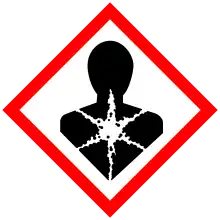Nickel(II) nitrate
Nickel nitrate is the inorganic compound Ni(NO3)2 or any hydrate thereof. The anhydrous form is not commonly encountered, thus "nickel nitrate" usually refers to nickel(II) nitrate hexahydrate. The formula for this species is written in two ways: Ni(NO3)2.6H2O and, more descriptively [Ni(H2O)6](NO3)2. The latter formula indicates that the nickel(II) center is surrounded by six water molecules in this hydrated salt. In the hexahydrate, the nitrate anions are not bonded to nickel. Also known are three other hydrates: Ni(NO3)2.9H2O, Ni(NO3)2.4H2O, and Ni(NO3)2.2H2O. Anhydrous Ni(NO3)2 is also known.[2]
2.svg.png.webp) | |
 | |
| Names | |
|---|---|
| IUPAC name
Nickel(II) nitrate | |
| Other names
Nickel nitrate Nickelous nitrate Nitric acid, nickel(2+) salt | |
| Identifiers | |
| |
3D model (JSmol) |
|
| ChemSpider | |
| ECHA InfoCard | 100.032.774 |
| EC Number |
|
PubChem CID |
|
| UNII |
|
| UN number | 2725 |
CompTox Dashboard (EPA) |
|
| |
| |
| Properties | |
| Ni(NO3)2 | |
| Molar mass | 182.703 g/mol (anhydrous) 290.79 g/mol (hexahydrate) |
| Appearance | emerald green hygroscopic solid |
| Odor | odorless |
| Density | 2.05 g/cm3 (hexahydrate) |
| Melting point | 56.7 °C (134.1 °F; 329.8 K) (hexahydrate) |
| Boiling point | 136.7 °C (278.1 °F; 409.8 K) (hexahydrate) |
| 243 (hexahydrate) g/100ml (0 °C)[1] | |
| Solubility | soluble in ethanol |
| +4300.0·10−6 cm3/mol (+6 H2O) | |
Refractive index (nD) |
1.422 (hexahydrate) |
| Structure | |
| monoclinic (hexahydrate) | |
| Hazards | |
| GHS labelling: | |
     | |
| Danger | |
| H272, H302, H315, H317, H318, H332, H334, H341, H350, H360, H372, H410 | |
| P201, P202, P210, P220, P221, P260, P261, P264, P270, P271, P272, P273, P280, P281, P285, P301+P312, P302+P352, P304+P312, P304+P340, P304+P341, P305+P351+P338, P308+P313, P310, P312, P314, P321, P330, P332+P313, P333+P313, P342+P311, P362, P363, P370+P378, P391, P405, P501 | |
| NFPA 704 (fire diamond) | |
| Flash point | Non-flammable |
| Lethal dose or concentration (LD, LC): | |
LD50 (median dose) |
1620 mg/kg (oral, rat) |
| Safety data sheet (SDS) | External MSDS |
| Related compounds | |
Other anions |
Nickel(II) sulfate Nickel(II) chloride |
Other cations |
Palladium(II) nitrate |
Related compounds |
Cobalt(II) nitrate Copper(II) nitrate |
Except where otherwise noted, data are given for materials in their standard state (at 25 °C [77 °F], 100 kPa).
Infobox references | |
It is prepared by the reaction of nickel oxide with nitric acid:
- NiO + 2 HNO3 + 5 H2O → Ni(NO3)2.6H2O
The anhydrous nickel nitrate is typically not prepared by heating the hydrates. Rather it is generated by the reaction of hydrates with dinitrogen pentoxide or of nickel carbonyl with dinitrogen tetroxide:[2]
- Ni(CO)4 + 2 N2O4 → Ni(NO3)2 + 2 NO + 4 CO
The hydrated nitrate is often used as a precursor to supported nickel catalysts.[2]
Structure
Nickel(II) compounds with oxygenated ligands often feature octahedral coordination geometry. Two polymorphs of the tetrahydrate Ni(NO3)2.4H2O have been crystallized. In one the monodentate nitrate ligands are trans[3] while in the other they are cis.[4]
Safety
Like other nitrates, nickel nitrate is oxidizing. It is also irritating to the eyes, skin and, upon inhalation of the dust, respiratory tract. It may cause skin allergy. Nickel nitrate is a carcinogen, along with most other nickel compounds. The nickel ion is also toxic to aquatic organisms.
Uses
Nickel(II) nitrate is primarily used in electrotyping and electroplating of metallic nickel.
References
- Perry's Chem Eng Handbook, 7th Ed
- Lascelles, Keith; Morgan, Lindsay G.; Nicholls, David; Beyersmann, Detmar (2005). "Nickel Compounds". Ullmann's Encyclopedia of Industrial Chemistry. Weinheim: Wiley-VCH. doi:10.1002/14356007.a17_235.pub2.
- Morosin, B.; Haseda, T. (1979). "Crystal Structure of the β Form of Ni(NO3)2.4H2O". Acta Crystallographica Section B: Structural Crystallography and Crystal Chemistry. 35 (12): 2856–2858. doi:10.1107/S0567740879010827.
- Gallezot, P.; Weigel, D.; Prettre, M. (1967). "Structure du Nitrate de Nickel Tétrahydraté". Acta Crystallographica. 22 (5): 699–705. doi:10.1107/S0365110X67001392.
